- Thread starter
- #3,881
Navigation
Install the app
How to install the app on iOS
Follow along with the video below to see how to install our site as a web app on your home screen.
Note: This feature may not be available in some browsers.
More options
You are using an out of date browser. It may not display this or other websites correctly.
You should upgrade or use an alternative browser.
You should upgrade or use an alternative browser.
Picture of the Day - Miscellaneous (18 Viewers)
- Thread starter Shinpachi
- Start date
Ad: This forum contains affiliate links to products on Amazon and eBay. More information in Terms and rules
More options
Who Replied?- Thread starter
- #3,883
- Thread starter
- #3,885
- Thread starter
- #3,888
Yes, they were, sotaro-sanThe 1968 cartoon was Jaqueline Bouvier and Aristotle Onassis? Great cartoons Shinpachi.
Pic on the back cover was this.
Source: Cartoon Magazine (Dec.1968)
- Thread starter
- #3,890
A Japanese professor questions American fashion in the street of Tokyo with his snapshots under the war.
Hair styles
View attachment 700959
Hats
View attachment 700960
Shoes and socks
View attachment 700961
Mannequins
View attachment 700962
Billboards
View attachment 700963
View attachment 700964
Label letters
View attachment 700965
Source: Nichirin (Sunburst/Feb. 1942)
American fashion was back three years later soon.
This was a good chance for the Japanese youths like my aunt and uncle as teens to learn it directly in the street.
Source: GHQカメラマンが見た戦後の日本 - 江戸の退屈御家人
Last edited:
manta22
Banned
Interesting photo, Shinpachi. In the early days of the Occupation, it was not uncommon to see both a Japanese policeman and an American MP at a street corner directing traffic as shown there.American fashion was back three years later soon.
This was a good chance for the Japanese youths like my aunt and uncle as teens to learn it directly in the street.
View attachment 701060
Source: GHQカメラマンが見た戦後の日本 - 江戸の退屈御家人
Last edited:
manta22
Banned
On the subject of "fashion" or simply "clothing", I will post a few pictures that are from my Mother & Father's collection. It was a tough time in Japan right after the end of the War; Japan's economy and industrial capacity were devastated and the major cities lay in ruins. Food, clothing, and other necessities were in short supply and some items were being rationed. New clothing was difficult for the Japanese people to find, much less be able to afford to buy. Women generally wore their older traditional clothing and looked very nice in public. Japanese men, on the other hand were not able to afford anything new at all. A Japanese businessman wore old Western-style suits but a working man had little choice in his clothing- an old Army uniform was frequently all he had. As Japan rebuilt and goods became available, the old Army uniforms gradually faded from public view. Those were a reliable barometer of the improving Japanese economy.School students wore typical uniforms. These 35mm slides illustrate the variety of clothing seen in Japan in the early Occupation years.
Attachments
-
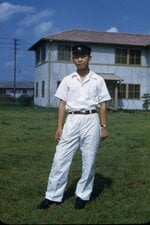 0130_Keiko Fukuda, Student.jpg2.5 MB · Views: 49
0130_Keiko Fukuda, Student.jpg2.5 MB · Views: 49 -
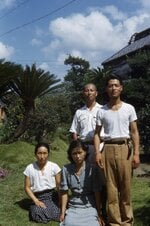 0131_Matsuda Family, Japan.jpg2.6 MB · Views: 47
0131_Matsuda Family, Japan.jpg2.6 MB · Views: 47 -
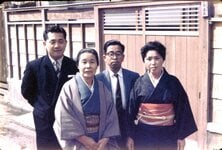 Fukuda Fanily 1960- Keiko (L).jpg392.5 KB · Views: 52
Fukuda Fanily 1960- Keiko (L).jpg392.5 KB · Views: 52 -
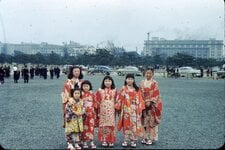 Japanese girls Imperial Plaza.jpg1.2 MB · Views: 49
Japanese girls Imperial Plaza.jpg1.2 MB · Views: 49 -
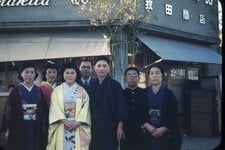 Makita family ca 1949.jpg808.6 KB · Views: 53
Makita family ca 1949.jpg808.6 KB · Views: 53 -
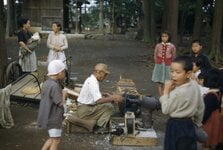 0125_Japanese Man Making Pop Corn -Exploding Rice.jpg2.3 MB · Views: 49
0125_Japanese Man Making Pop Corn -Exploding Rice.jpg2.3 MB · Views: 49 -
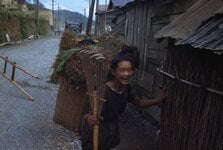 0124_Japanese Girl With Basket of Twigs -Near Kamakura.jpg2.4 MB · Views: 48
0124_Japanese Girl With Basket of Twigs -Near Kamakura.jpg2.4 MB · Views: 48 -
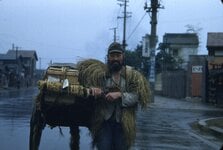 0102_Japanese Farmer Pulling Cart in Straw Raincoat.jpg2.6 MB · Views: 42
0102_Japanese Farmer Pulling Cart in Straw Raincoat.jpg2.6 MB · Views: 42 -
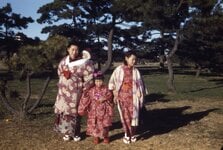 0035_114 Japanese Mother and Children.jpg2.5 MB · Views: 46
0035_114 Japanese Mother and Children.jpg2.5 MB · Views: 46 -
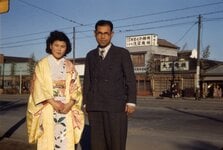 0034_110 Hiriko & Yu Makita.jpg2.4 MB · Views: 44
0034_110 Hiriko & Yu Makita.jpg2.4 MB · Views: 44 -
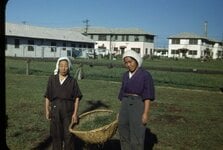 0008_60 Grass Cutters- Grant Heights.jpg2.4 MB · Views: 53
0008_60 Grass Cutters- Grant Heights.jpg2.4 MB · Views: 53 -
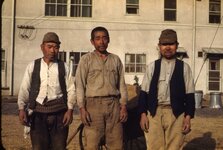 0006_160 Workmen 214C Grant Heights.jpg2.5 MB · Views: 44
0006_160 Workmen 214C Grant Heights.jpg2.5 MB · Views: 44
manta22
Banned
A few more typical scenes, including B&W photos.
Attachments
-
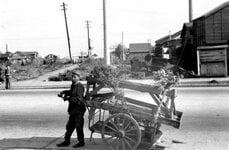 Flower Peddler on Yokohama Road.jpg834.9 KB · Views: 43
Flower Peddler on Yokohama Road.jpg834.9 KB · Views: 43 -
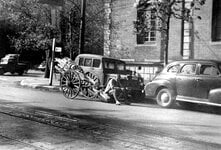 Japanese Coolie Cart Puller-Tokyo 1948.jpg2.6 MB · Views: 42
Japanese Coolie Cart Puller-Tokyo 1948.jpg2.6 MB · Views: 42 -
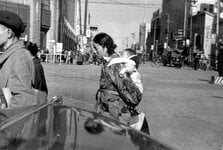 Japanese Woman & Child-Tokyo 1948 Isetan Shinjuku Dept Store on Left.jpg2.3 MB · Views: 44
Japanese Woman & Child-Tokyo 1948 Isetan Shinjuku Dept Store on Left.jpg2.3 MB · Views: 44 -
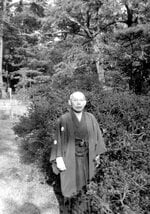 Mr Okamoto, Tea Ceremony Teacher-Meiji Park 1948.jpg2.3 MB · Views: 44
Mr Okamoto, Tea Ceremony Teacher-Meiji Park 1948.jpg2.3 MB · Views: 44 -
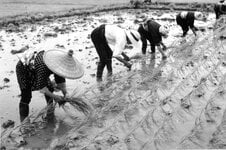 Planting Rice- 1948.jpg2.4 MB · Views: 47
Planting Rice- 1948.jpg2.4 MB · Views: 47 -
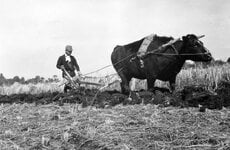 Plowing With Ox- Japan 1948 a.jpg145.2 KB · Views: 44
Plowing With Ox- Japan 1948 a.jpg145.2 KB · Views: 44 -
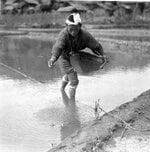 Sewing Rice-Japan.jpg3.6 MB · Views: 46
Sewing Rice-Japan.jpg3.6 MB · Views: 46 -
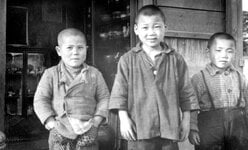 Japanese Kids- Tokyo 1948 a.jpg89.1 KB · Views: 42
Japanese Kids- Tokyo 1948 a.jpg89.1 KB · Views: 42
- Thread starter
- #3,895
manta22
Banned
No, but I saw "Seven Samurai"
- Thread starter
- #3,897
No, but I saw "Seven Samurai"
My father was enjoying his single life soon after the war ended but one day he had been introduced such a "bad" girl for his future bride by parents. Later, he told his kids "I immediately married another girl. She is your mother!"
Snautzer01
Marshal
- 46,292
- Mar 26, 2007
Escuadrilla Azul
Tech Sergeant
- 2,120
- Feb 27, 2020
Those colour pics are awesome!On the subject of "fashion" or simply "clothing", I will post a few pictures that are from my Mother & Father's collection. It was a tough time in Japan right after the end of the War; Japan's economy and industrial capacity were devastated and the major cities lay in ruins. Food, clothing, and other necessities were in short supply and some items were being rationed. New clothing was difficult for the Japanese people to find, much less be able to afford to buy. Women generally wore their older traditional clothing and looked very nice in public. Japanese men, on the other hand were not able to afford anything new at all. A Japanese businessman wore old Western-style suits but a working man had little choice in his clothing- an old Army uniform was frequently all he had. As Japan rebuilt and goods became available, the old Army uniforms gradually faded from public view. Those were a reliable barometer of the improving Japanese economy.School students wore typical uniforms. These 35mm slides illustrate the variety of clothing seen in Japan in the early Occupation years.
- Thread starter
- #3,900
I did not know that there was such a Japanese song as "Gomen nasai (I am so sorry)" in 1953 but was introduced as a very popular song in the US.
Ten years earlier than "Sukiyaki". Royalty is said having donated to the Elizabeth Saunders Home.

Source: World Entertainment Pictorial (June 1953)
Ten years earlier than "Sukiyaki". Royalty is said having donated to the Elizabeth Saunders Home.
Source: World Entertainment Pictorial (June 1953)
Users who are viewing this thread
Total: 19 (members: 0, guests: 19)
Similar threads
- Replies
- 9
- Views
- 2K
